The room for the car is often not heated, so condensation appears on the walls, in winter the temperature drops below zero, in summer it is hot. The interior decoration of the garage must withstand aggressive components. Substances fall on vertical and horizontal surfaces in the form of droplets of oil, gasoline or are contained in the ambient air. The material is chosen so that the walls, floor and ceiling have a pleasant design, and the coating is practical.
Interior wall and ceiling cladding materials
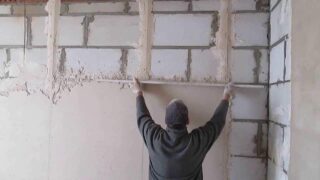
The finish must withstand frost, as well as repeated thawing and freezing without loss of quality and appearance. Materials are chosen non-combustible, since flammable liquids are stored in the garage.
Varieties are used for interior decoration:
- simple and decorative plaster;
- plastic panels;
- ceramic tile;
- sheathing with OSB panels;
- moisture-resistant or fire-resistant drywall;
- wooden lining;
- professional sheet.
Before choosing a material, take into account that it must be durable, easy to clean, the price of the finished coating also plays a role. Many owners prefer to decorate the walls inside and outside with their own hands, so they choose a simple technology. If you need to insulate the enclosing structures, they are sheathed on the basis of the frame.
Plaster
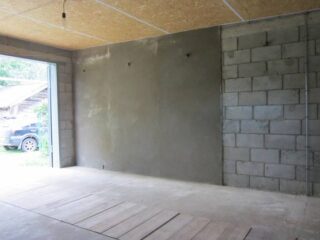
Low-cost version of the finish, therefore popular. You can do a simple coating or spray and get a decorative layer. Sand, cement, water are used for the solution. There are dry, ready-to-use formulations that are sold in bags. They have added polymer modifiers to improve properties.
Plaster has advantages:
- evens out the plane, but does not reduce the squaring of the garage;
- durable, long-term operation;
- resistant to mold, low temperatures, moisture.
Plaster is referred to as a wet process when mortar mixing is used. You can apply the layer with your own hands, but you need to have initial skills. The work is carried out at positive temperatures, otherwise cracks will go. The surface is painted to facilitate cleaning of dust and debris.
PVC panels
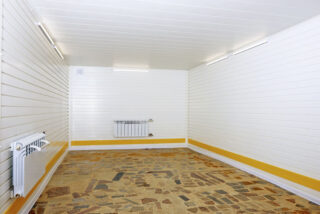
A wide variety of plastic slats are sold, which differ in width, strip thickness, can form a plane with longitudinal seams or a seamless surface. Plain PVC material is produced, or a pattern of marble, wood, stone is applied.
Pros in favor of plastic:
- low cost;
- water resistance;
- elementary care;
- light weight, maintainability;
- no need to apply topcoat.
The disadvantages include weak strength against impacts, the possibility of warping thin plastic when exposed to heat. Decorating the walls in the garage with plastic is carried out on the frame, if you need to install wall insulation. Another option involves gluing directly to the surface, but the method requires vertical alignment.
Tile
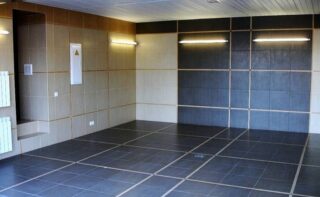
Ceramic cladding is a suitable finish for garage walls. You can choose the material by color, quality, pattern and texture, the cost depends on it.Before the start of finishing, the walls are leveled with plaster in order to reduce the consumption of the adhesive mixture. Combined cladding is used when the bottom is made with porcelain stoneware, and a less durable tile is used on the top.
Advantages of a tiled layer on the walls:
- resistance to frost, moisture, fire;
- hygiene, easy cleaning;
- strength and durability.
The rather high cost of quality tiles is becoming an obstacle to widespread use. To lay the material beautifully, you need the skill of facing or you need to order the services of a tile.
Plywood

Such a wall covering is not often used, since unfinished panels swell from moisture, then, in frost, they begin to warp and delaminate. Before installation, the sheets are treated with agents to increase moisture resistance, against microorganisms, and increase protection against rapid ignition. Use a thickness of 10 to 25 mm, take laminated types.
The advantages of pre-processed materials include:
- low price;
- neat appearance.
After installation, the finished surface is painted with oil, latex, enamel compounds, varnished. This finish increases the durability of use. Plywood is glued directly to even walls or a frame base is made if it is required to strengthen the protection of vertical fences from the cold.
OSB slabs
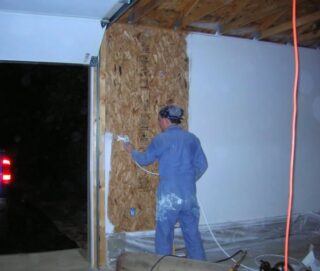
Chipboards are produced from sawn timber waste, and the gluing component is waxy substances, resins, paraffins. The material has increased water-repellent characteristics, so the inside of the garage cladding is of higher quality than the plywood layer.
Positive material properties:
- do not swell, microorganisms and mold do not develop on the plane;
- strong, durable;
- differ in small mass;
- poorly transmitting sound, heat.
The disadvantage is the flammability of OSB boards, the content of harmful formaldehydes inside, which are gradually released into the atmosphere of the room. Such wall covering requires a mandatory ventilation device.
Drywall
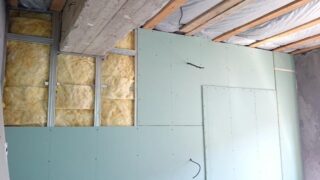
The material belongs to the category that is used in various premises, including garage. In conditions of high humidity, instability of the microclimate, moisture-resistant panels (green) and fire-resistant options (gray) are used. For installation, a frame is constructed from a galvanized profile. Installation of sheets is simple, the main thing is to correctly level the supporting elements.
Advantages of g / cardboard:
- inexpensive material;
- quick installation without dirt;
- you can put insulation.
G / cardboard is mounted on glue without a frame, using pads in the form of beacons. After installation, the material requires a finishing putty and painting with acrylic, latex compounds. The final finishing takes a long time.
Lining
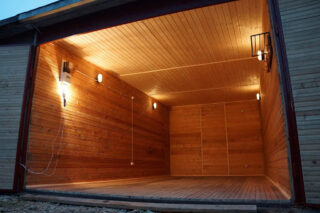
A covering made of natural or artificial material adds aesthetics to the garage premises, increases comfort. This is important if the workshop is used for work, as well as for the rest of friends. You can decorate the walls in the garage with g / cardboard with your own hands, while you must follow the established technology, choose the right natural material.
The advantages of finishing:
- low cost of softwood lining;
- strength, durability of the coating;
- easy installation on a frame made of wooden slats;
- high thermal insulation qualities.
Natural lining is afraid of moisture, quickly ignites in case of fire. The material is damaged by pests, microorganisms. The lamellas are pretreated with antiseptics, fire retardants in order to increase the resistance to these factors.
Professional list
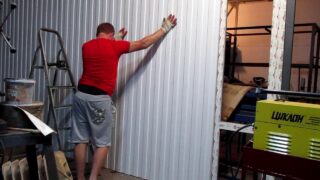
Not a bad option to decorate the garage inside, the cladding is inexpensive, while practical. Steel sheet is galvanized at the factory, then covered with a polymer layer. The quality characteristics of the metal are preserved; in addition, the material receives protection from corrosion, moisture, and aggressive substances. They put the corrugated board on a frame made of wood or a galvanized profile.
Positive traits:
- strength, durability;
- moisture resistance;
- quick installation;
- wide range of choice in color, pattern, waveform.
The professional sheet is used both for interior decoration and for sewing frame walls made of wooden or metal racks. In case of improper cutting, transportation, protection is impaired and corrosion begins.
Floor materials
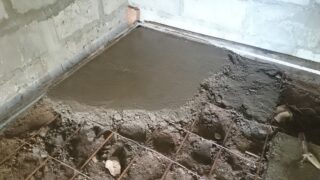
For cladding garage floors, wooden boards and porcelain stoneware are used. Paving slabs are a good option for finishing garage driveways and interior spaces, and sometimes floors are concreted for a durable finish. A suitable alternative is sheet metal or asphalting.
The floor is under static load from a heavy machine, dynamic when entering and exiting, therefore materials of sufficient reliability and durable are used. Drops of gasoline, oil, diesel fuel regularly appear on the floor, so the coating should not be destroyed from such an action.
With wheels and shoes, dirt and moisture get on the floor; when choosing a coating, I take into account moisture resistance. Fast cleaning and hygiene are what counts.
Concrete
An affordable and budget option is used by many garage owners, since the installation does not take much time, it is easy to do on your own. The solution is kneaded in a concrete mixer so as not to carry out heavy manual work. For concreting, beacons from pipes, rails, profiles are preliminarily set to the desired height.
Benefits of a concrete floor:
- high strength, long period of use;
- the possibility of partial repair;
- moisture resistance, frost resistance.
The disadvantages include a long set of 100% strength. It is possible to drive the car into the garage after concreting only after 25 - 28 days. A gray floor will look dull if you do not put ceramic or finish painting on it.
Paving slabs
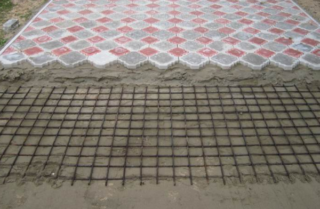
An original and aesthetic solution for the garage floor. The base is crushed stone bedding and a layer of dry sand with cement. In a garage, the floor experiences dynamic forces when the machine is stopped, so a reinforcing mesh is laid for basic strength. The tiles themselves have sufficient bearing capacity to support the weight of the car.
Qualitative characteristics:
- waterproof and fireproof;
- beautiful view;
- ease of operation, the possibility of repair.
Good material is expensive, and cheap stones are not suitable for garage floors. The masonry is carried out with elements with a rough surface to reduce slipping, but such surfaces accumulate dust and dirt and are difficult to clean.
Wood
Boards for a garage floor are rarely used, since the material is not quite suitable for this in quality. The wear resistance of lumber is low, the strength is insufficient for the regular action of statics and dynamics from transport. The wooden covering will not last long, it is considered as a temporary finishing option. You can put oak boards, but the cost of such a surface is high and is not considered relevant for a garage.
Wood requires pre-treatment before installation, but the sewn layer will quickly wear off, regular impregnation and staining of damaged areas will be required. For flooring, boards with a thickness of at least 40 mm are taken, they are placed on logs made of wood, moisture-resistant species, for example, larch, are used.
Ceramic tile
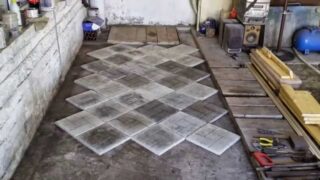
For garage flooring, use porcelain stoneware or clinker. Reliable coating looks aesthetically pleasing and is of high quality. The material is ideal, but expensive, so it is not often used.
Qualitative indicators:
- high resistance to wear, high load-bearing capacity, durability;
- inability to absorb water, resistance to fire;
- ease of cleaning.
For the tile, a base is prepared in the form of a concrete layer. You can put the material on your own, if you have a little experience. For grouting, plastic compounds are used that do not collapse from stress.
The difference in the decoration of a heated and unheated room
The garage is classified as a room with a difficult climate inside. It is heated most often during work, and the rest of the time in winter there is a low temperature, high humidity.
In the decoration of unheated garages, plastic, ceramics are used, concreting, porcelain stoneware, and paving slabs are made on the floors. By this, the materials do not react to negative conditions, do not deteriorate over time. Finishing work is carried out at a temperature of + 5 ° C, so that wet species can dry out and gain strength. If it is necessary to concrete the floor in frost, the mass is heated with electrodes so that the material sets and does not freeze.
In insulated and heated hangars, the requirements for finishing layers are not so strict. You can put drywall, plywood, use thick boards on the floor.
Design guidelines

The room should have a business look, while having a laconic interior of a certain style. They choose non-staining and practical colors, shades of medium intensity. At the entrance, the impression of solidity and thrift should be created. Repair of walls or floors is carried out in a timely manner so that there is no feeling of neglect and negligence.
As a supplement, shelves are thoughtfully designed, all the necessary tools should be at hand. Lighting is performed organically so that there are no dark corners. A workplace with a workbench is designed to match the entire room or stand out with its own style, for example, wood panels, a different paint color.
Wood is combined with brick, painted with plaster, g / cardboard, and tiles are perfectly adjacent to concrete and plastic. The top of the walls is finished with PVC panels, where there are no shock loads, and the lower panels are made with ceramics, decorative plaster.
For waste disposal, a place is allocated and decorated in the style of the main decoration, so that it is not striking.








